Taxation Report: Capital Gains, Fringe Benefits Tax, and Provisions
VerifiedAdded on 2023/06/05
|14
|4553
|286
Report
AI Summary
This report delves into the intricacies of Australian taxation, specifically focusing on capital gains tax and fringe benefits tax. The first part examines a case study involving Amber, who sold a shop, including stock, equipment, and goodwill, and also received payment for a non-compete agreement. The analysis covers the relevant provisions of the Income Tax Assessment Act 1997, including the calculation of capital gains and losses on the sale of various assets, the treatment of goodwill, and the implications of acquiring and disposing of residential property, including inherited property. The second part of the report focuses on fringe benefits tax, analyzing a case involving Jamie, an employee of a real estate company, and the various benefits provided to him, such as commissions, a company car, and other perks. The report assesses how these benefits are taxed under the fringe benefits tax regime, providing a comprehensive overview of the tax implications for both the employer and the employee. The report utilizes relevant sections of the Income Tax Assessment Act to support the analysis.
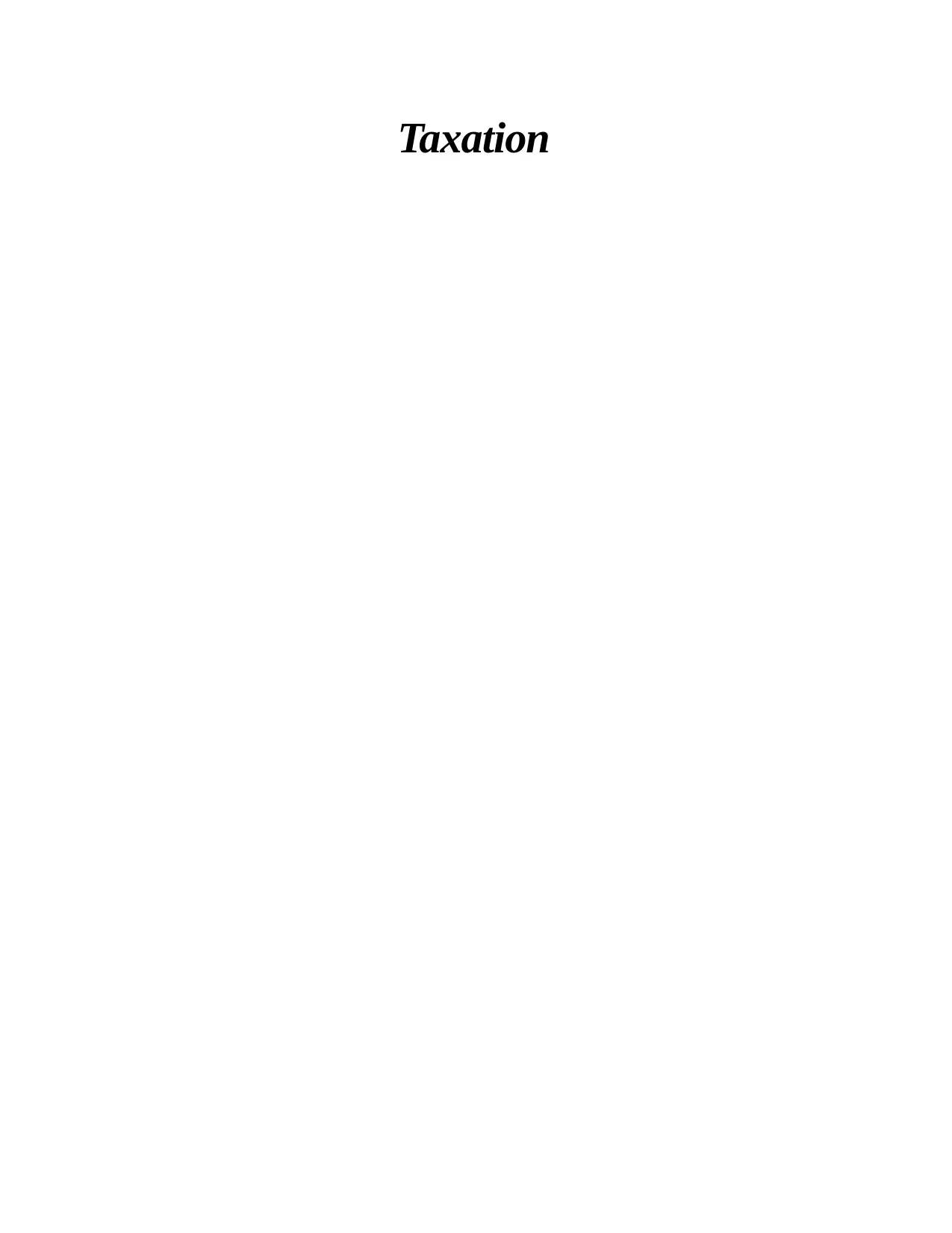
Taxation
Paraphrase This Document
Need a fresh take? Get an instant paraphrase of this document with our AI Paraphraser
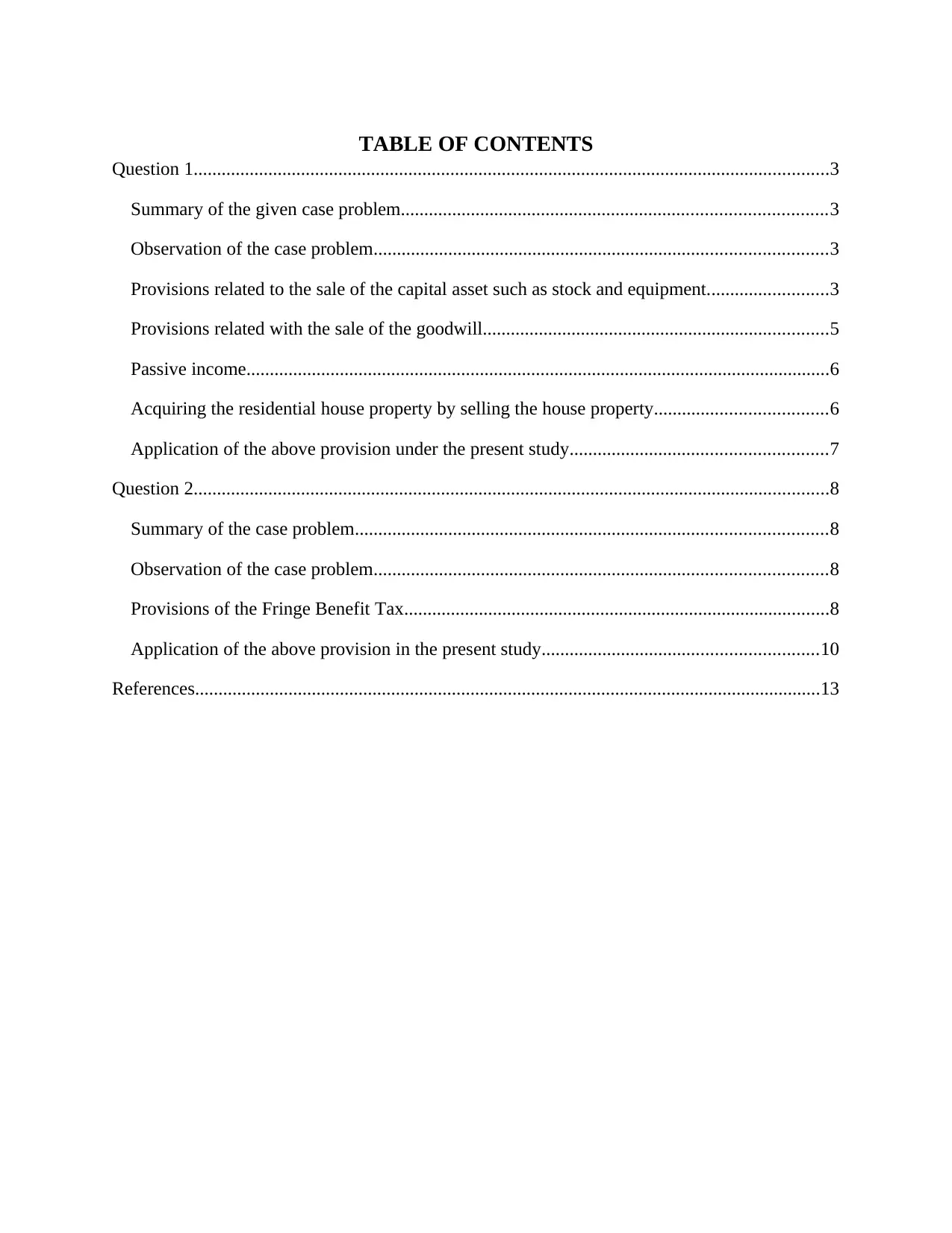
TABLE OF CONTENTS
Question 1........................................................................................................................................3
Summary of the given case problem...........................................................................................3
Observation of the case problem.................................................................................................3
Provisions related to the sale of the capital asset such as stock and equipment..........................3
Provisions related with the sale of the goodwill..........................................................................5
Passive income.............................................................................................................................6
Acquiring the residential house property by selling the house property.....................................6
Application of the above provision under the present study.......................................................7
Question 2........................................................................................................................................8
Summary of the case problem.....................................................................................................8
Observation of the case problem.................................................................................................8
Provisions of the Fringe Benefit Tax...........................................................................................8
Application of the above provision in the present study...........................................................10
References......................................................................................................................................13
Question 1........................................................................................................................................3
Summary of the given case problem...........................................................................................3
Observation of the case problem.................................................................................................3
Provisions related to the sale of the capital asset such as stock and equipment..........................3
Provisions related with the sale of the goodwill..........................................................................5
Passive income.............................................................................................................................6
Acquiring the residential house property by selling the house property.....................................6
Application of the above provision under the present study.......................................................7
Question 2........................................................................................................................................8
Summary of the case problem.....................................................................................................8
Observation of the case problem.................................................................................................8
Provisions of the Fringe Benefit Tax...........................................................................................8
Application of the above provision in the present study...........................................................10
References......................................................................................................................................13
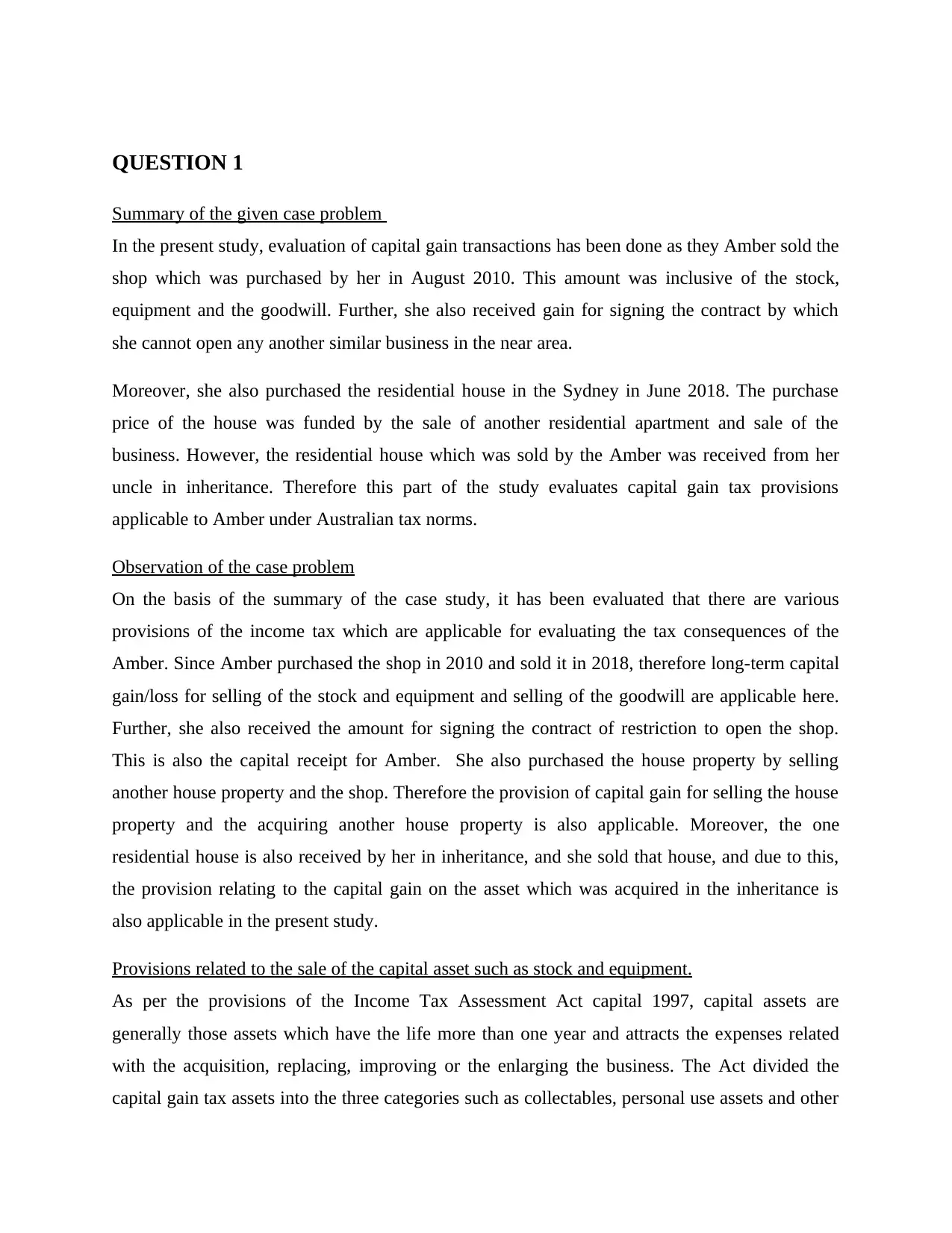
QUESTION 1
Summary of the given case problem
In the present study, evaluation of capital gain transactions has been done as they Amber sold the
shop which was purchased by her in August 2010. This amount was inclusive of the stock,
equipment and the goodwill. Further, she also received gain for signing the contract by which
she cannot open any another similar business in the near area.
Moreover, she also purchased the residential house in the Sydney in June 2018. The purchase
price of the house was funded by the sale of another residential apartment and sale of the
business. However, the residential house which was sold by the Amber was received from her
uncle in inheritance. Therefore this part of the study evaluates capital gain tax provisions
applicable to Amber under Australian tax norms.
Observation of the case problem
On the basis of the summary of the case study, it has been evaluated that there are various
provisions of the income tax which are applicable for evaluating the tax consequences of the
Amber. Since Amber purchased the shop in 2010 and sold it in 2018, therefore long-term capital
gain/loss for selling of the stock and equipment and selling of the goodwill are applicable here.
Further, she also received the amount for signing the contract of restriction to open the shop.
This is also the capital receipt for Amber. She also purchased the house property by selling
another house property and the shop. Therefore the provision of capital gain for selling the house
property and the acquiring another house property is also applicable. Moreover, the one
residential house is also received by her in inheritance, and she sold that house, and due to this,
the provision relating to the capital gain on the asset which was acquired in the inheritance is
also applicable in the present study.
Provisions related to the sale of the capital asset such as stock and equipment.
As per the provisions of the Income Tax Assessment Act capital 1997, capital assets are
generally those assets which have the life more than one year and attracts the expenses related
with the acquisition, replacing, improving or the enlarging the business. The Act divided the
capital gain tax assets into the three categories such as collectables, personal use assets and other
Summary of the given case problem
In the present study, evaluation of capital gain transactions has been done as they Amber sold the
shop which was purchased by her in August 2010. This amount was inclusive of the stock,
equipment and the goodwill. Further, she also received gain for signing the contract by which
she cannot open any another similar business in the near area.
Moreover, she also purchased the residential house in the Sydney in June 2018. The purchase
price of the house was funded by the sale of another residential apartment and sale of the
business. However, the residential house which was sold by the Amber was received from her
uncle in inheritance. Therefore this part of the study evaluates capital gain tax provisions
applicable to Amber under Australian tax norms.
Observation of the case problem
On the basis of the summary of the case study, it has been evaluated that there are various
provisions of the income tax which are applicable for evaluating the tax consequences of the
Amber. Since Amber purchased the shop in 2010 and sold it in 2018, therefore long-term capital
gain/loss for selling of the stock and equipment and selling of the goodwill are applicable here.
Further, she also received the amount for signing the contract of restriction to open the shop.
This is also the capital receipt for Amber. She also purchased the house property by selling
another house property and the shop. Therefore the provision of capital gain for selling the house
property and the acquiring another house property is also applicable. Moreover, the one
residential house is also received by her in inheritance, and she sold that house, and due to this,
the provision relating to the capital gain on the asset which was acquired in the inheritance is
also applicable in the present study.
Provisions related to the sale of the capital asset such as stock and equipment.
As per the provisions of the Income Tax Assessment Act capital 1997, capital assets are
generally those assets which have the life more than one year and attracts the expenses related
with the acquisition, replacing, improving or the enlarging the business. The Act divided the
capital gain tax assets into the three categories such as collectables, personal use assets and other
⊘ This is a preview!⊘
Do you want full access?
Subscribe today to unlock all pages.

Trusted by 1+ million students worldwide
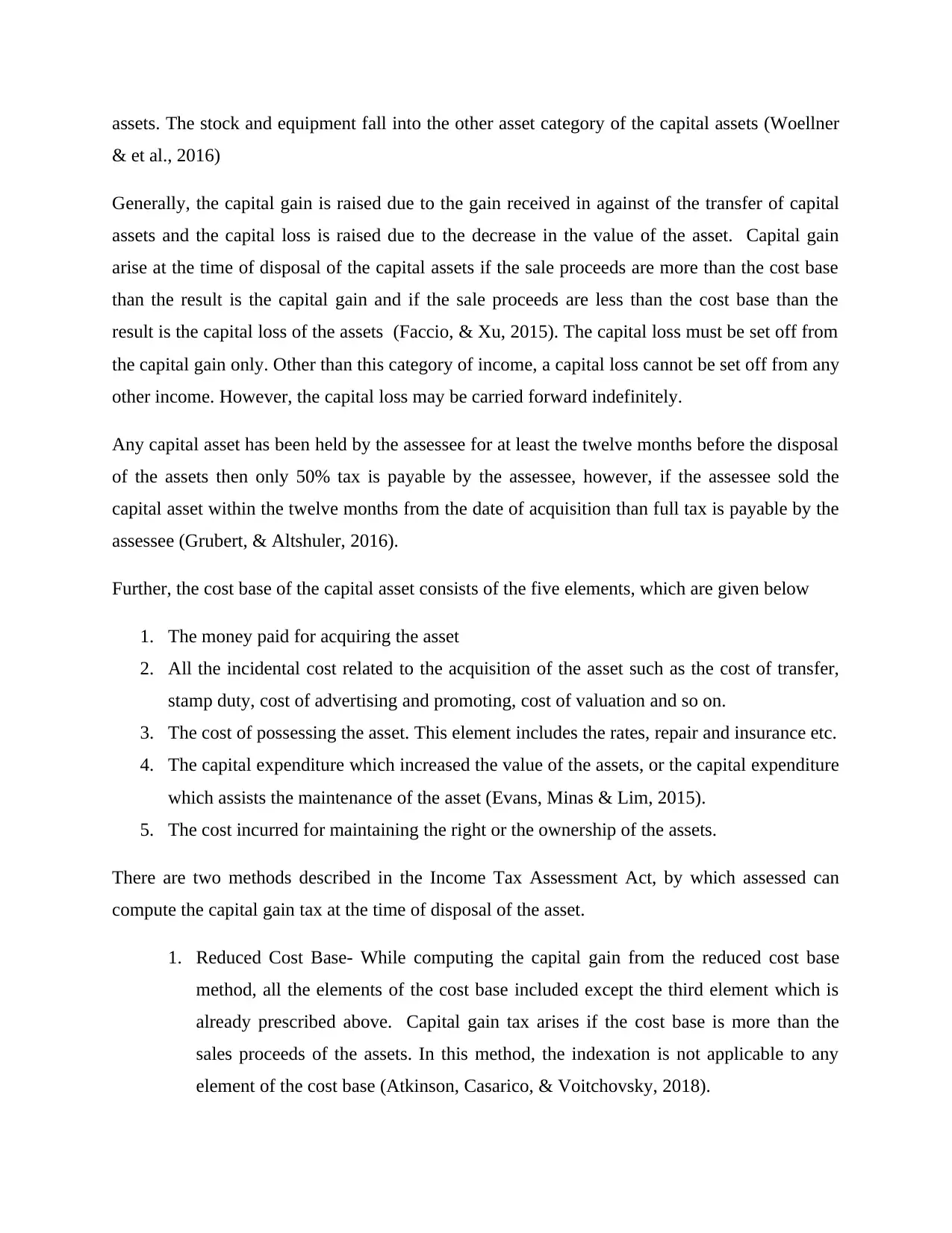
assets. The stock and equipment fall into the other asset category of the capital assets (Woellner
& et al., 2016)
Generally, the capital gain is raised due to the gain received in against of the transfer of capital
assets and the capital loss is raised due to the decrease in the value of the asset. Capital gain
arise at the time of disposal of the capital assets if the sale proceeds are more than the cost base
than the result is the capital gain and if the sale proceeds are less than the cost base than the
result is the capital loss of the assets (Faccio, & Xu, 2015). The capital loss must be set off from
the capital gain only. Other than this category of income, a capital loss cannot be set off from any
other income. However, the capital loss may be carried forward indefinitely.
Any capital asset has been held by the assessee for at least the twelve months before the disposal
of the assets then only 50% tax is payable by the assessee, however, if the assessee sold the
capital asset within the twelve months from the date of acquisition than full tax is payable by the
assessee (Grubert, & Altshuler, 2016).
Further, the cost base of the capital asset consists of the five elements, which are given below
1. The money paid for acquiring the asset
2. All the incidental cost related to the acquisition of the asset such as the cost of transfer,
stamp duty, cost of advertising and promoting, cost of valuation and so on.
3. The cost of possessing the asset. This element includes the rates, repair and insurance etc.
4. The capital expenditure which increased the value of the assets, or the capital expenditure
which assists the maintenance of the asset (Evans, Minas & Lim, 2015).
5. The cost incurred for maintaining the right or the ownership of the assets.
There are two methods described in the Income Tax Assessment Act, by which assessed can
compute the capital gain tax at the time of disposal of the asset.
1. Reduced Cost Base- While computing the capital gain from the reduced cost base
method, all the elements of the cost base included except the third element which is
already prescribed above. Capital gain tax arises if the cost base is more than the
sales proceeds of the assets. In this method, the indexation is not applicable to any
element of the cost base (Atkinson, Casarico, & Voitchovsky, 2018).
& et al., 2016)
Generally, the capital gain is raised due to the gain received in against of the transfer of capital
assets and the capital loss is raised due to the decrease in the value of the asset. Capital gain
arise at the time of disposal of the capital assets if the sale proceeds are more than the cost base
than the result is the capital gain and if the sale proceeds are less than the cost base than the
result is the capital loss of the assets (Faccio, & Xu, 2015). The capital loss must be set off from
the capital gain only. Other than this category of income, a capital loss cannot be set off from any
other income. However, the capital loss may be carried forward indefinitely.
Any capital asset has been held by the assessee for at least the twelve months before the disposal
of the assets then only 50% tax is payable by the assessee, however, if the assessee sold the
capital asset within the twelve months from the date of acquisition than full tax is payable by the
assessee (Grubert, & Altshuler, 2016).
Further, the cost base of the capital asset consists of the five elements, which are given below
1. The money paid for acquiring the asset
2. All the incidental cost related to the acquisition of the asset such as the cost of transfer,
stamp duty, cost of advertising and promoting, cost of valuation and so on.
3. The cost of possessing the asset. This element includes the rates, repair and insurance etc.
4. The capital expenditure which increased the value of the assets, or the capital expenditure
which assists the maintenance of the asset (Evans, Minas & Lim, 2015).
5. The cost incurred for maintaining the right or the ownership of the assets.
There are two methods described in the Income Tax Assessment Act, by which assessed can
compute the capital gain tax at the time of disposal of the asset.
1. Reduced Cost Base- While computing the capital gain from the reduced cost base
method, all the elements of the cost base included except the third element which is
already prescribed above. Capital gain tax arises if the cost base is more than the
sales proceeds of the assets. In this method, the indexation is not applicable to any
element of the cost base (Atkinson, Casarico, & Voitchovsky, 2018).
Paraphrase This Document
Need a fresh take? Get an instant paraphrase of this document with our AI Paraphraser
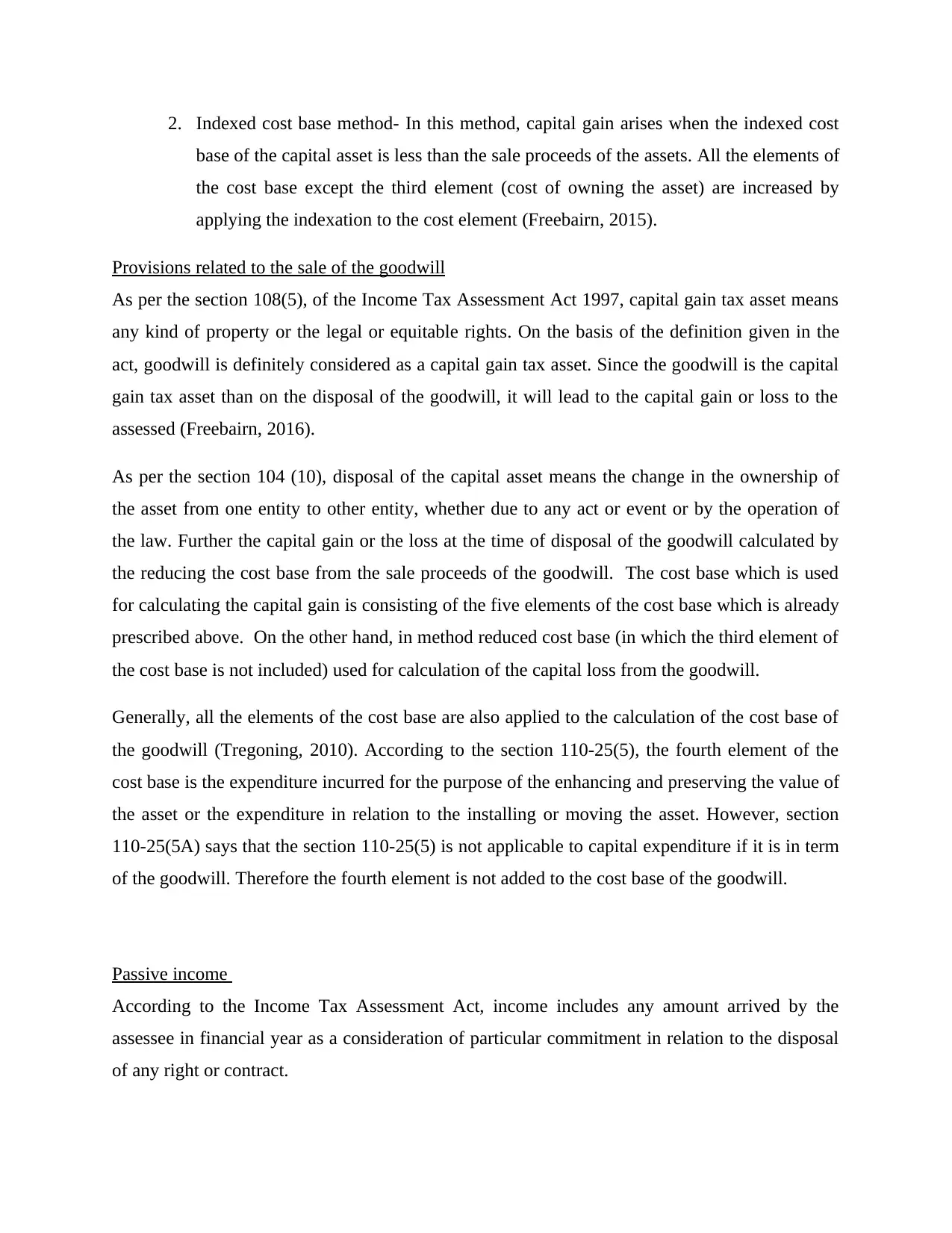
2. Indexed cost base method- In this method, capital gain arises when the indexed cost
base of the capital asset is less than the sale proceeds of the assets. All the elements of
the cost base except the third element (cost of owning the asset) are increased by
applying the indexation to the cost element (Freebairn, 2015).
Provisions related to the sale of the goodwill
As per the section 108(5), of the Income Tax Assessment Act 1997, capital gain tax asset means
any kind of property or the legal or equitable rights. On the basis of the definition given in the
act, goodwill is definitely considered as a capital gain tax asset. Since the goodwill is the capital
gain tax asset than on the disposal of the goodwill, it will lead to the capital gain or loss to the
assessed (Freebairn, 2016).
As per the section 104 (10), disposal of the capital asset means the change in the ownership of
the asset from one entity to other entity, whether due to any act or event or by the operation of
the law. Further the capital gain or the loss at the time of disposal of the goodwill calculated by
the reducing the cost base from the sale proceeds of the goodwill. The cost base which is used
for calculating the capital gain is consisting of the five elements of the cost base which is already
prescribed above. On the other hand, in method reduced cost base (in which the third element of
the cost base is not included) used for calculation of the capital loss from the goodwill.
Generally, all the elements of the cost base are also applied to the calculation of the cost base of
the goodwill (Tregoning, 2010). According to the section 110-25(5), the fourth element of the
cost base is the expenditure incurred for the purpose of the enhancing and preserving the value of
the asset or the expenditure in relation to the installing or moving the asset. However, section
110-25(5A) says that the section 110-25(5) is not applicable to capital expenditure if it is in term
of the goodwill. Therefore the fourth element is not added to the cost base of the goodwill.
Passive income
According to the Income Tax Assessment Act, income includes any amount arrived by the
assessee in financial year as a consideration of particular commitment in relation to the disposal
of any right or contract.
base of the capital asset is less than the sale proceeds of the assets. All the elements of
the cost base except the third element (cost of owning the asset) are increased by
applying the indexation to the cost element (Freebairn, 2015).
Provisions related to the sale of the goodwill
As per the section 108(5), of the Income Tax Assessment Act 1997, capital gain tax asset means
any kind of property or the legal or equitable rights. On the basis of the definition given in the
act, goodwill is definitely considered as a capital gain tax asset. Since the goodwill is the capital
gain tax asset than on the disposal of the goodwill, it will lead to the capital gain or loss to the
assessed (Freebairn, 2016).
As per the section 104 (10), disposal of the capital asset means the change in the ownership of
the asset from one entity to other entity, whether due to any act or event or by the operation of
the law. Further the capital gain or the loss at the time of disposal of the goodwill calculated by
the reducing the cost base from the sale proceeds of the goodwill. The cost base which is used
for calculating the capital gain is consisting of the five elements of the cost base which is already
prescribed above. On the other hand, in method reduced cost base (in which the third element of
the cost base is not included) used for calculation of the capital loss from the goodwill.
Generally, all the elements of the cost base are also applied to the calculation of the cost base of
the goodwill (Tregoning, 2010). According to the section 110-25(5), the fourth element of the
cost base is the expenditure incurred for the purpose of the enhancing and preserving the value of
the asset or the expenditure in relation to the installing or moving the asset. However, section
110-25(5A) says that the section 110-25(5) is not applicable to capital expenditure if it is in term
of the goodwill. Therefore the fourth element is not added to the cost base of the goodwill.
Passive income
According to the Income Tax Assessment Act, income includes any amount arrived by the
assessee in financial year as a consideration of particular commitment in relation to the disposal
of any right or contract.
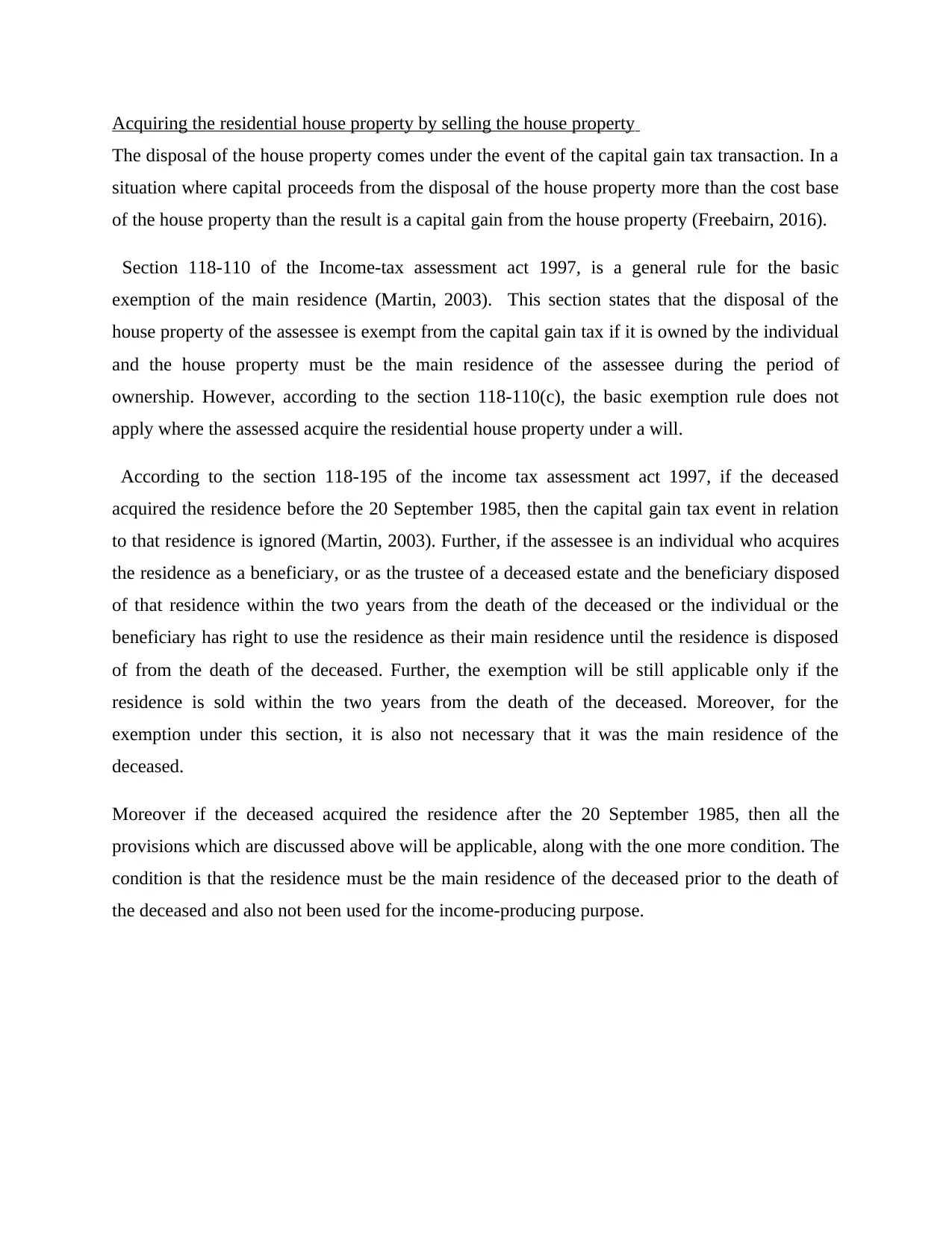
Acquiring the residential house property by selling the house property
The disposal of the house property comes under the event of the capital gain tax transaction. In a
situation where capital proceeds from the disposal of the house property more than the cost base
of the house property than the result is a capital gain from the house property (Freebairn, 2016).
Section 118-110 of the Income-tax assessment act 1997, is a general rule for the basic
exemption of the main residence (Martin, 2003). This section states that the disposal of the
house property of the assessee is exempt from the capital gain tax if it is owned by the individual
and the house property must be the main residence of the assessee during the period of
ownership. However, according to the section 118-110(c), the basic exemption rule does not
apply where the assessed acquire the residential house property under a will.
According to the section 118-195 of the income tax assessment act 1997, if the deceased
acquired the residence before the 20 September 1985, then the capital gain tax event in relation
to that residence is ignored (Martin, 2003). Further, if the assessee is an individual who acquires
the residence as a beneficiary, or as the trustee of a deceased estate and the beneficiary disposed
of that residence within the two years from the death of the deceased or the individual or the
beneficiary has right to use the residence as their main residence until the residence is disposed
of from the death of the deceased. Further, the exemption will be still applicable only if the
residence is sold within the two years from the death of the deceased. Moreover, for the
exemption under this section, it is also not necessary that it was the main residence of the
deceased.
Moreover if the deceased acquired the residence after the 20 September 1985, then all the
provisions which are discussed above will be applicable, along with the one more condition. The
condition is that the residence must be the main residence of the deceased prior to the death of
the deceased and also not been used for the income-producing purpose.
The disposal of the house property comes under the event of the capital gain tax transaction. In a
situation where capital proceeds from the disposal of the house property more than the cost base
of the house property than the result is a capital gain from the house property (Freebairn, 2016).
Section 118-110 of the Income-tax assessment act 1997, is a general rule for the basic
exemption of the main residence (Martin, 2003). This section states that the disposal of the
house property of the assessee is exempt from the capital gain tax if it is owned by the individual
and the house property must be the main residence of the assessee during the period of
ownership. However, according to the section 118-110(c), the basic exemption rule does not
apply where the assessed acquire the residential house property under a will.
According to the section 118-195 of the income tax assessment act 1997, if the deceased
acquired the residence before the 20 September 1985, then the capital gain tax event in relation
to that residence is ignored (Martin, 2003). Further, if the assessee is an individual who acquires
the residence as a beneficiary, or as the trustee of a deceased estate and the beneficiary disposed
of that residence within the two years from the death of the deceased or the individual or the
beneficiary has right to use the residence as their main residence until the residence is disposed
of from the death of the deceased. Further, the exemption will be still applicable only if the
residence is sold within the two years from the death of the deceased. Moreover, for the
exemption under this section, it is also not necessary that it was the main residence of the
deceased.
Moreover if the deceased acquired the residence after the 20 September 1985, then all the
provisions which are discussed above will be applicable, along with the one more condition. The
condition is that the residence must be the main residence of the deceased prior to the death of
the deceased and also not been used for the income-producing purpose.
⊘ This is a preview!⊘
Do you want full access?
Subscribe today to unlock all pages.

Trusted by 1+ million students worldwide
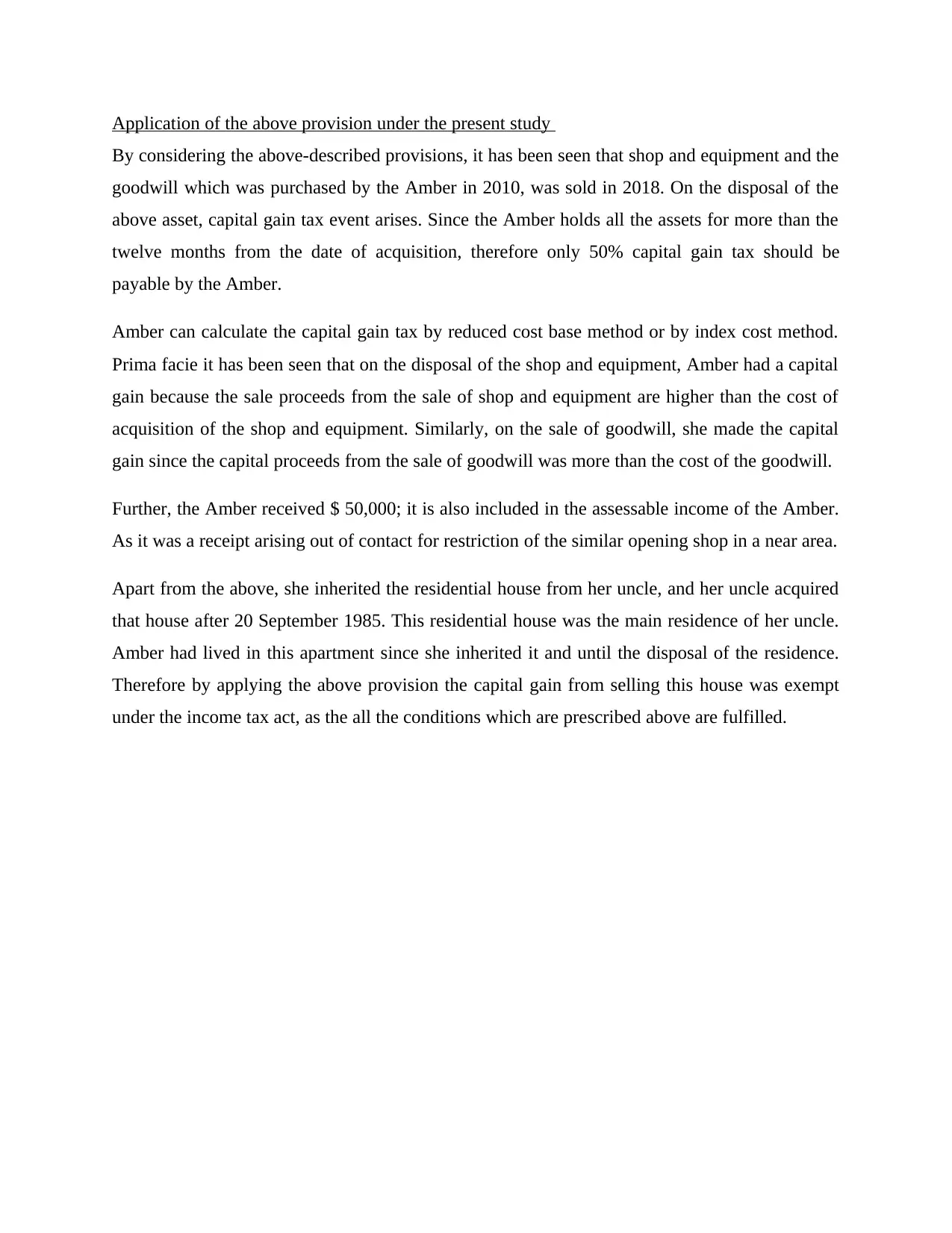
Application of the above provision under the present study
By considering the above-described provisions, it has been seen that shop and equipment and the
goodwill which was purchased by the Amber in 2010, was sold in 2018. On the disposal of the
above asset, capital gain tax event arises. Since the Amber holds all the assets for more than the
twelve months from the date of acquisition, therefore only 50% capital gain tax should be
payable by the Amber.
Amber can calculate the capital gain tax by reduced cost base method or by index cost method.
Prima facie it has been seen that on the disposal of the shop and equipment, Amber had a capital
gain because the sale proceeds from the sale of shop and equipment are higher than the cost of
acquisition of the shop and equipment. Similarly, on the sale of goodwill, she made the capital
gain since the capital proceeds from the sale of goodwill was more than the cost of the goodwill.
Further, the Amber received $ 50,000; it is also included in the assessable income of the Amber.
As it was a receipt arising out of contact for restriction of the similar opening shop in a near area.
Apart from the above, she inherited the residential house from her uncle, and her uncle acquired
that house after 20 September 1985. This residential house was the main residence of her uncle.
Amber had lived in this apartment since she inherited it and until the disposal of the residence.
Therefore by applying the above provision the capital gain from selling this house was exempt
under the income tax act, as the all the conditions which are prescribed above are fulfilled.
By considering the above-described provisions, it has been seen that shop and equipment and the
goodwill which was purchased by the Amber in 2010, was sold in 2018. On the disposal of the
above asset, capital gain tax event arises. Since the Amber holds all the assets for more than the
twelve months from the date of acquisition, therefore only 50% capital gain tax should be
payable by the Amber.
Amber can calculate the capital gain tax by reduced cost base method or by index cost method.
Prima facie it has been seen that on the disposal of the shop and equipment, Amber had a capital
gain because the sale proceeds from the sale of shop and equipment are higher than the cost of
acquisition of the shop and equipment. Similarly, on the sale of goodwill, she made the capital
gain since the capital proceeds from the sale of goodwill was more than the cost of the goodwill.
Further, the Amber received $ 50,000; it is also included in the assessable income of the Amber.
As it was a receipt arising out of contact for restriction of the similar opening shop in a near area.
Apart from the above, she inherited the residential house from her uncle, and her uncle acquired
that house after 20 September 1985. This residential house was the main residence of her uncle.
Amber had lived in this apartment since she inherited it and until the disposal of the residence.
Therefore by applying the above provision the capital gain from selling this house was exempt
under the income tax act, as the all the conditions which are prescribed above are fulfilled.
Paraphrase This Document
Need a fresh take? Get an instant paraphrase of this document with our AI Paraphraser
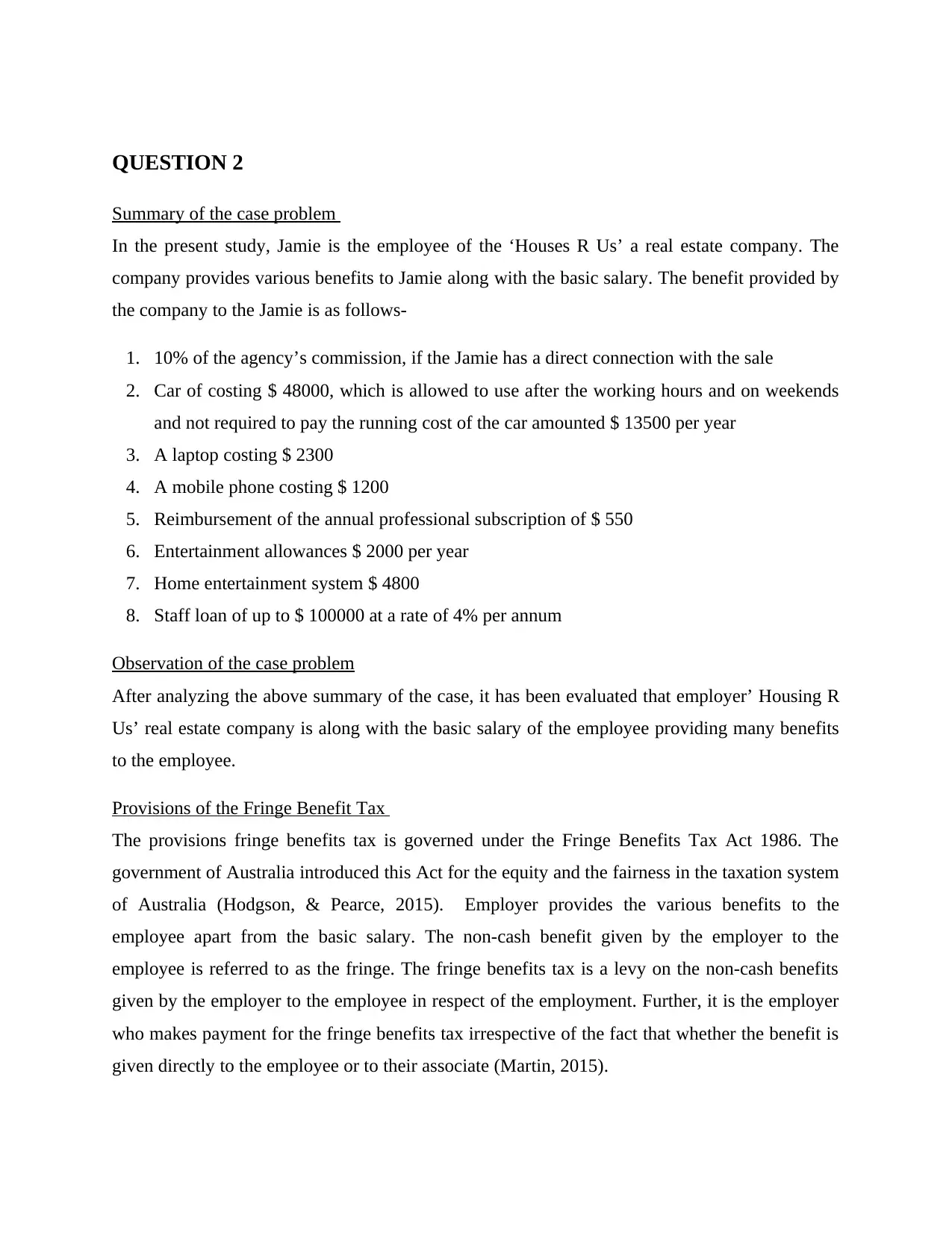
QUESTION 2
Summary of the case problem
In the present study, Jamie is the employee of the ‘Houses R Us’ a real estate company. The
company provides various benefits to Jamie along with the basic salary. The benefit provided by
the company to the Jamie is as follows-
1. 10% of the agency’s commission, if the Jamie has a direct connection with the sale
2. Car of costing $ 48000, which is allowed to use after the working hours and on weekends
and not required to pay the running cost of the car amounted $ 13500 per year
3. A laptop costing $ 2300
4. A mobile phone costing $ 1200
5. Reimbursement of the annual professional subscription of $ 550
6. Entertainment allowances $ 2000 per year
7. Home entertainment system $ 4800
8. Staff loan of up to $ 100000 at a rate of 4% per annum
Observation of the case problem
After analyzing the above summary of the case, it has been evaluated that employer’ Housing R
Us’ real estate company is along with the basic salary of the employee providing many benefits
to the employee.
Provisions of the Fringe Benefit Tax
The provisions fringe benefits tax is governed under the Fringe Benefits Tax Act 1986. The
government of Australia introduced this Act for the equity and the fairness in the taxation system
of Australia (Hodgson, & Pearce, 2015). Employer provides the various benefits to the
employee apart from the basic salary. The non-cash benefit given by the employer to the
employee is referred to as the fringe. The fringe benefits tax is a levy on the non-cash benefits
given by the employer to the employee in respect of the employment. Further, it is the employer
who makes payment for the fringe benefits tax irrespective of the fact that whether the benefit is
given directly to the employee or to their associate (Martin, 2015).
Summary of the case problem
In the present study, Jamie is the employee of the ‘Houses R Us’ a real estate company. The
company provides various benefits to Jamie along with the basic salary. The benefit provided by
the company to the Jamie is as follows-
1. 10% of the agency’s commission, if the Jamie has a direct connection with the sale
2. Car of costing $ 48000, which is allowed to use after the working hours and on weekends
and not required to pay the running cost of the car amounted $ 13500 per year
3. A laptop costing $ 2300
4. A mobile phone costing $ 1200
5. Reimbursement of the annual professional subscription of $ 550
6. Entertainment allowances $ 2000 per year
7. Home entertainment system $ 4800
8. Staff loan of up to $ 100000 at a rate of 4% per annum
Observation of the case problem
After analyzing the above summary of the case, it has been evaluated that employer’ Housing R
Us’ real estate company is along with the basic salary of the employee providing many benefits
to the employee.
Provisions of the Fringe Benefit Tax
The provisions fringe benefits tax is governed under the Fringe Benefits Tax Act 1986. The
government of Australia introduced this Act for the equity and the fairness in the taxation system
of Australia (Hodgson, & Pearce, 2015). Employer provides the various benefits to the
employee apart from the basic salary. The non-cash benefit given by the employer to the
employee is referred to as the fringe. The fringe benefits tax is a levy on the non-cash benefits
given by the employer to the employee in respect of the employment. Further, it is the employer
who makes payment for the fringe benefits tax irrespective of the fact that whether the benefit is
given directly to the employee or to their associate (Martin, 2015).
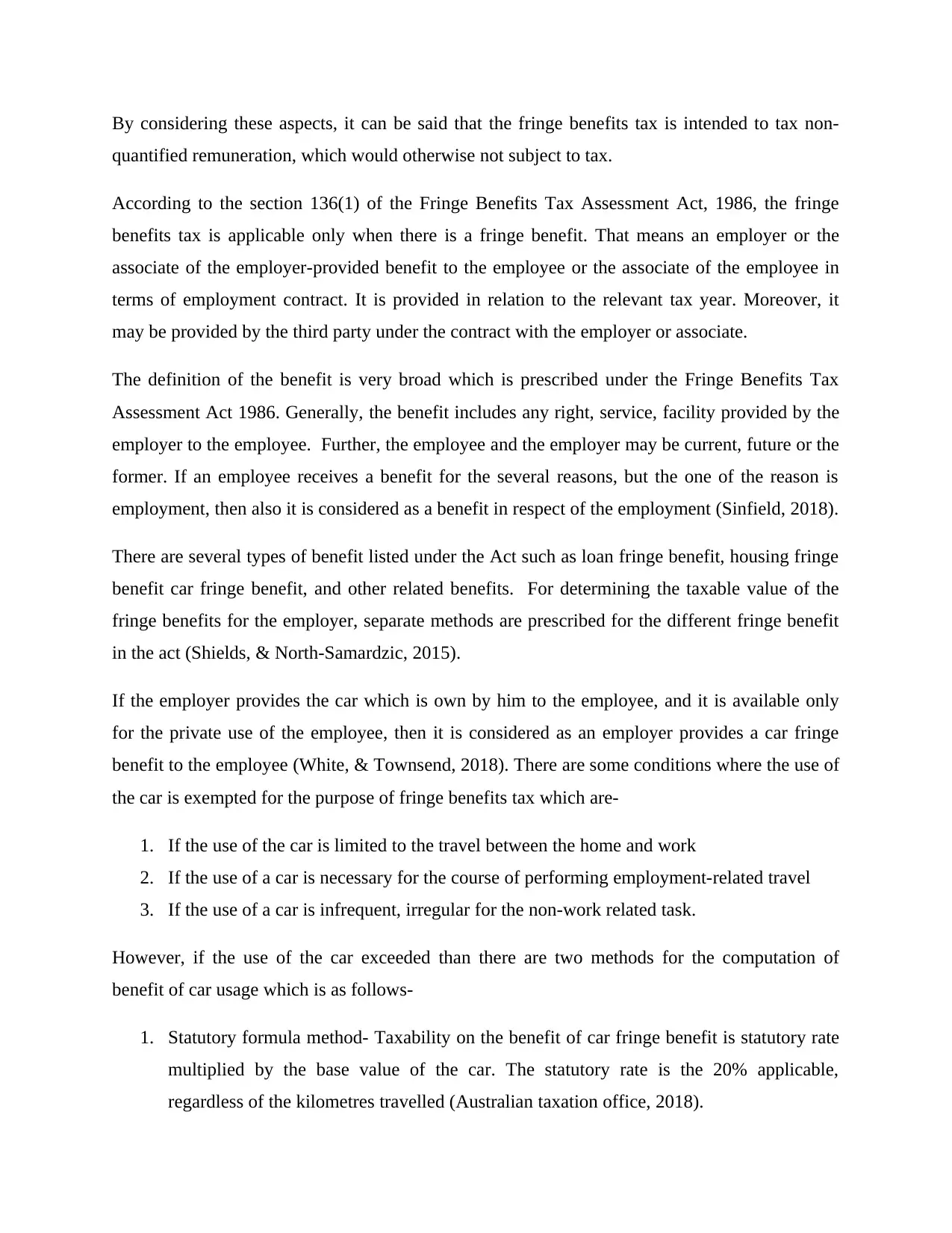
By considering these aspects, it can be said that the fringe benefits tax is intended to tax non-
quantified remuneration, which would otherwise not subject to tax.
According to the section 136(1) of the Fringe Benefits Tax Assessment Act, 1986, the fringe
benefits tax is applicable only when there is a fringe benefit. That means an employer or the
associate of the employer-provided benefit to the employee or the associate of the employee in
terms of employment contract. It is provided in relation to the relevant tax year. Moreover, it
may be provided by the third party under the contract with the employer or associate.
The definition of the benefit is very broad which is prescribed under the Fringe Benefits Tax
Assessment Act 1986. Generally, the benefit includes any right, service, facility provided by the
employer to the employee. Further, the employee and the employer may be current, future or the
former. If an employee receives a benefit for the several reasons, but the one of the reason is
employment, then also it is considered as a benefit in respect of the employment (Sinfield, 2018).
There are several types of benefit listed under the Act such as loan fringe benefit, housing fringe
benefit car fringe benefit, and other related benefits. For determining the taxable value of the
fringe benefits for the employer, separate methods are prescribed for the different fringe benefit
in the act (Shields, & North-Samardzic, 2015).
If the employer provides the car which is own by him to the employee, and it is available only
for the private use of the employee, then it is considered as an employer provides a car fringe
benefit to the employee (White, & Townsend, 2018). There are some conditions where the use of
the car is exempted for the purpose of fringe benefits tax which are-
1. If the use of the car is limited to the travel between the home and work
2. If the use of a car is necessary for the course of performing employment-related travel
3. If the use of a car is infrequent, irregular for the non-work related task.
However, if the use of the car exceeded than there are two methods for the computation of
benefit of car usage which is as follows-
1. Statutory formula method- Taxability on the benefit of car fringe benefit is statutory rate
multiplied by the base value of the car. The statutory rate is the 20% applicable,
regardless of the kilometres travelled (Australian taxation office, 2018).
quantified remuneration, which would otherwise not subject to tax.
According to the section 136(1) of the Fringe Benefits Tax Assessment Act, 1986, the fringe
benefits tax is applicable only when there is a fringe benefit. That means an employer or the
associate of the employer-provided benefit to the employee or the associate of the employee in
terms of employment contract. It is provided in relation to the relevant tax year. Moreover, it
may be provided by the third party under the contract with the employer or associate.
The definition of the benefit is very broad which is prescribed under the Fringe Benefits Tax
Assessment Act 1986. Generally, the benefit includes any right, service, facility provided by the
employer to the employee. Further, the employee and the employer may be current, future or the
former. If an employee receives a benefit for the several reasons, but the one of the reason is
employment, then also it is considered as a benefit in respect of the employment (Sinfield, 2018).
There are several types of benefit listed under the Act such as loan fringe benefit, housing fringe
benefit car fringe benefit, and other related benefits. For determining the taxable value of the
fringe benefits for the employer, separate methods are prescribed for the different fringe benefit
in the act (Shields, & North-Samardzic, 2015).
If the employer provides the car which is own by him to the employee, and it is available only
for the private use of the employee, then it is considered as an employer provides a car fringe
benefit to the employee (White, & Townsend, 2018). There are some conditions where the use of
the car is exempted for the purpose of fringe benefits tax which are-
1. If the use of the car is limited to the travel between the home and work
2. If the use of a car is necessary for the course of performing employment-related travel
3. If the use of a car is infrequent, irregular for the non-work related task.
However, if the use of the car exceeded than there are two methods for the computation of
benefit of car usage which is as follows-
1. Statutory formula method- Taxability on the benefit of car fringe benefit is statutory rate
multiplied by the base value of the car. The statutory rate is the 20% applicable,
regardless of the kilometres travelled (Australian taxation office, 2018).
⊘ This is a preview!⊘
Do you want full access?
Subscribe today to unlock all pages.

Trusted by 1+ million students worldwide
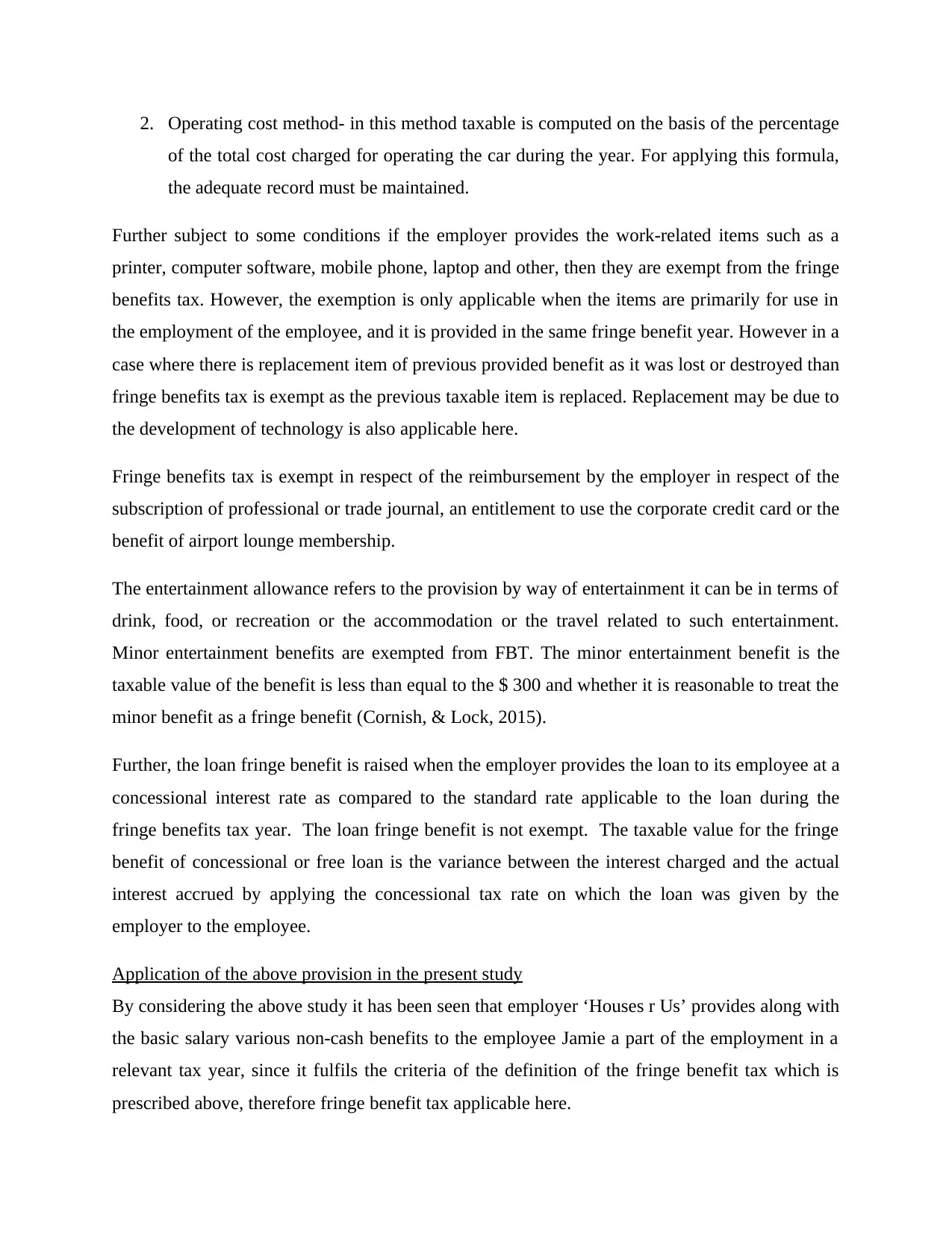
2. Operating cost method- in this method taxable is computed on the basis of the percentage
of the total cost charged for operating the car during the year. For applying this formula,
the adequate record must be maintained.
Further subject to some conditions if the employer provides the work-related items such as a
printer, computer software, mobile phone, laptop and other, then they are exempt from the fringe
benefits tax. However, the exemption is only applicable when the items are primarily for use in
the employment of the employee, and it is provided in the same fringe benefit year. However in a
case where there is replacement item of previous provided benefit as it was lost or destroyed than
fringe benefits tax is exempt as the previous taxable item is replaced. Replacement may be due to
the development of technology is also applicable here.
Fringe benefits tax is exempt in respect of the reimbursement by the employer in respect of the
subscription of professional or trade journal, an entitlement to use the corporate credit card or the
benefit of airport lounge membership.
The entertainment allowance refers to the provision by way of entertainment it can be in terms of
drink, food, or recreation or the accommodation or the travel related to such entertainment.
Minor entertainment benefits are exempted from FBT. The minor entertainment benefit is the
taxable value of the benefit is less than equal to the $ 300 and whether it is reasonable to treat the
minor benefit as a fringe benefit (Cornish, & Lock, 2015).
Further, the loan fringe benefit is raised when the employer provides the loan to its employee at a
concessional interest rate as compared to the standard rate applicable to the loan during the
fringe benefits tax year. The loan fringe benefit is not exempt. The taxable value for the fringe
benefit of concessional or free loan is the variance between the interest charged and the actual
interest accrued by applying the concessional tax rate on which the loan was given by the
employer to the employee.
Application of the above provision in the present study
By considering the above study it has been seen that employer ‘Houses r Us’ provides along with
the basic salary various non-cash benefits to the employee Jamie a part of the employment in a
relevant tax year, since it fulfils the criteria of the definition of the fringe benefit tax which is
prescribed above, therefore fringe benefit tax applicable here.
of the total cost charged for operating the car during the year. For applying this formula,
the adequate record must be maintained.
Further subject to some conditions if the employer provides the work-related items such as a
printer, computer software, mobile phone, laptop and other, then they are exempt from the fringe
benefits tax. However, the exemption is only applicable when the items are primarily for use in
the employment of the employee, and it is provided in the same fringe benefit year. However in a
case where there is replacement item of previous provided benefit as it was lost or destroyed than
fringe benefits tax is exempt as the previous taxable item is replaced. Replacement may be due to
the development of technology is also applicable here.
Fringe benefits tax is exempt in respect of the reimbursement by the employer in respect of the
subscription of professional or trade journal, an entitlement to use the corporate credit card or the
benefit of airport lounge membership.
The entertainment allowance refers to the provision by way of entertainment it can be in terms of
drink, food, or recreation or the accommodation or the travel related to such entertainment.
Minor entertainment benefits are exempted from FBT. The minor entertainment benefit is the
taxable value of the benefit is less than equal to the $ 300 and whether it is reasonable to treat the
minor benefit as a fringe benefit (Cornish, & Lock, 2015).
Further, the loan fringe benefit is raised when the employer provides the loan to its employee at a
concessional interest rate as compared to the standard rate applicable to the loan during the
fringe benefits tax year. The loan fringe benefit is not exempt. The taxable value for the fringe
benefit of concessional or free loan is the variance between the interest charged and the actual
interest accrued by applying the concessional tax rate on which the loan was given by the
employer to the employee.
Application of the above provision in the present study
By considering the above study it has been seen that employer ‘Houses r Us’ provides along with
the basic salary various non-cash benefits to the employee Jamie a part of the employment in a
relevant tax year, since it fulfils the criteria of the definition of the fringe benefit tax which is
prescribed above, therefore fringe benefit tax applicable here.
Paraphrase This Document
Need a fresh take? Get an instant paraphrase of this document with our AI Paraphraser
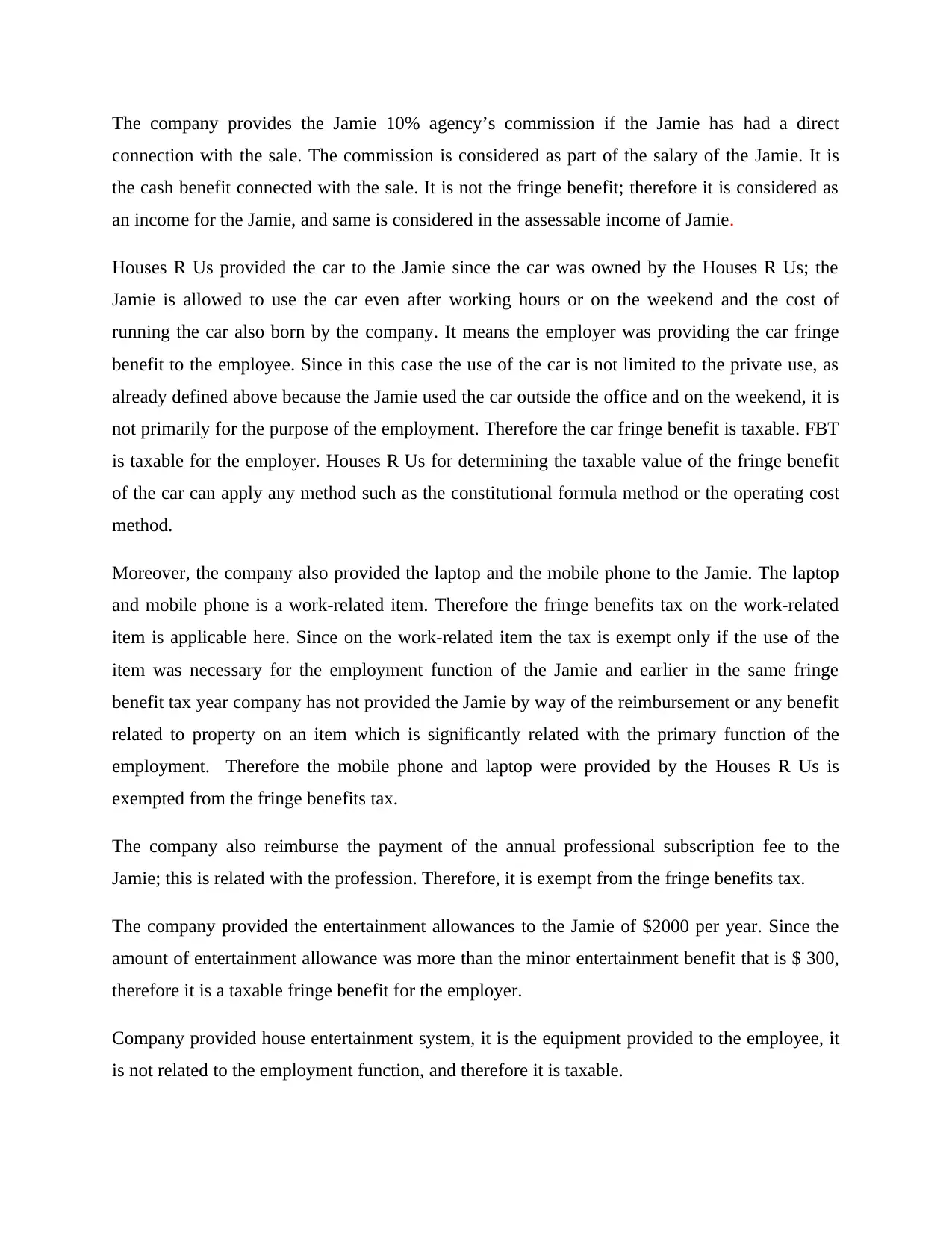
The company provides the Jamie 10% agency’s commission if the Jamie has had a direct
connection with the sale. The commission is considered as part of the salary of the Jamie. It is
the cash benefit connected with the sale. It is not the fringe benefit; therefore it is considered as
an income for the Jamie, and same is considered in the assessable income of Jamie.
Houses R Us provided the car to the Jamie since the car was owned by the Houses R Us; the
Jamie is allowed to use the car even after working hours or on the weekend and the cost of
running the car also born by the company. It means the employer was providing the car fringe
benefit to the employee. Since in this case the use of the car is not limited to the private use, as
already defined above because the Jamie used the car outside the office and on the weekend, it is
not primarily for the purpose of the employment. Therefore the car fringe benefit is taxable. FBT
is taxable for the employer. Houses R Us for determining the taxable value of the fringe benefit
of the car can apply any method such as the constitutional formula method or the operating cost
method.
Moreover, the company also provided the laptop and the mobile phone to the Jamie. The laptop
and mobile phone is a work-related item. Therefore the fringe benefits tax on the work-related
item is applicable here. Since on the work-related item the tax is exempt only if the use of the
item was necessary for the employment function of the Jamie and earlier in the same fringe
benefit tax year company has not provided the Jamie by way of the reimbursement or any benefit
related to property on an item which is significantly related with the primary function of the
employment. Therefore the mobile phone and laptop were provided by the Houses R Us is
exempted from the fringe benefits tax.
The company also reimburse the payment of the annual professional subscription fee to the
Jamie; this is related with the profession. Therefore, it is exempt from the fringe benefits tax.
The company provided the entertainment allowances to the Jamie of $2000 per year. Since the
amount of entertainment allowance was more than the minor entertainment benefit that is $ 300,
therefore it is a taxable fringe benefit for the employer.
Company provided house entertainment system, it is the equipment provided to the employee, it
is not related to the employment function, and therefore it is taxable.
connection with the sale. The commission is considered as part of the salary of the Jamie. It is
the cash benefit connected with the sale. It is not the fringe benefit; therefore it is considered as
an income for the Jamie, and same is considered in the assessable income of Jamie.
Houses R Us provided the car to the Jamie since the car was owned by the Houses R Us; the
Jamie is allowed to use the car even after working hours or on the weekend and the cost of
running the car also born by the company. It means the employer was providing the car fringe
benefit to the employee. Since in this case the use of the car is not limited to the private use, as
already defined above because the Jamie used the car outside the office and on the weekend, it is
not primarily for the purpose of the employment. Therefore the car fringe benefit is taxable. FBT
is taxable for the employer. Houses R Us for determining the taxable value of the fringe benefit
of the car can apply any method such as the constitutional formula method or the operating cost
method.
Moreover, the company also provided the laptop and the mobile phone to the Jamie. The laptop
and mobile phone is a work-related item. Therefore the fringe benefits tax on the work-related
item is applicable here. Since on the work-related item the tax is exempt only if the use of the
item was necessary for the employment function of the Jamie and earlier in the same fringe
benefit tax year company has not provided the Jamie by way of the reimbursement or any benefit
related to property on an item which is significantly related with the primary function of the
employment. Therefore the mobile phone and laptop were provided by the Houses R Us is
exempted from the fringe benefits tax.
The company also reimburse the payment of the annual professional subscription fee to the
Jamie; this is related with the profession. Therefore, it is exempt from the fringe benefits tax.
The company provided the entertainment allowances to the Jamie of $2000 per year. Since the
amount of entertainment allowance was more than the minor entertainment benefit that is $ 300,
therefore it is a taxable fringe benefit for the employer.
Company provided house entertainment system, it is the equipment provided to the employee, it
is not related to the employment function, and therefore it is taxable.
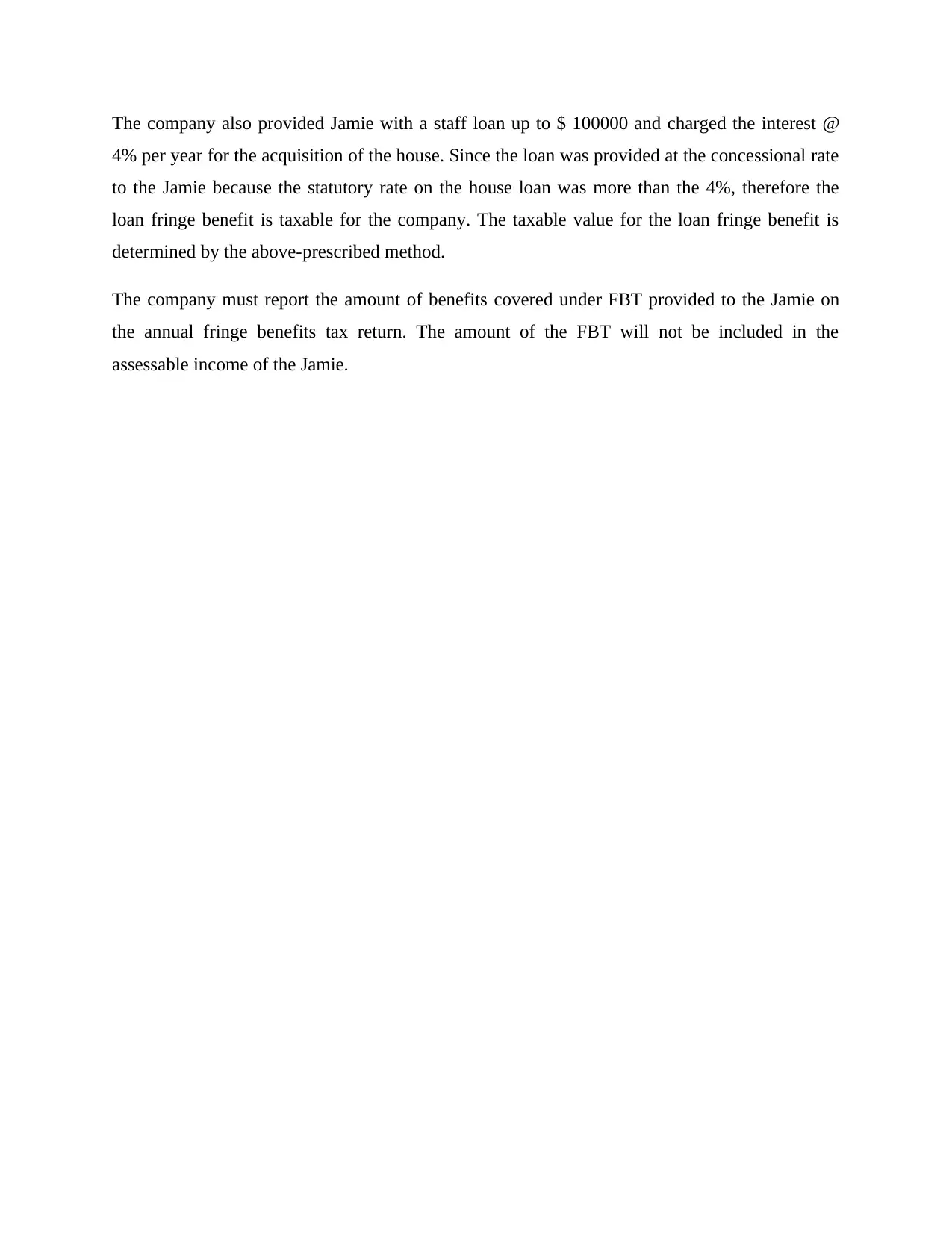
The company also provided Jamie with a staff loan up to $ 100000 and charged the interest @
4% per year for the acquisition of the house. Since the loan was provided at the concessional rate
to the Jamie because the statutory rate on the house loan was more than the 4%, therefore the
loan fringe benefit is taxable for the company. The taxable value for the loan fringe benefit is
determined by the above-prescribed method.
The company must report the amount of benefits covered under FBT provided to the Jamie on
the annual fringe benefits tax return. The amount of the FBT will not be included in the
assessable income of the Jamie.
4% per year for the acquisition of the house. Since the loan was provided at the concessional rate
to the Jamie because the statutory rate on the house loan was more than the 4%, therefore the
loan fringe benefit is taxable for the company. The taxable value for the loan fringe benefit is
determined by the above-prescribed method.
The company must report the amount of benefits covered under FBT provided to the Jamie on
the annual fringe benefits tax return. The amount of the FBT will not be included in the
assessable income of the Jamie.
⊘ This is a preview!⊘
Do you want full access?
Subscribe today to unlock all pages.

Trusted by 1+ million students worldwide
1 out of 14
Related Documents
Your All-in-One AI-Powered Toolkit for Academic Success.
+13062052269
info@desklib.com
Available 24*7 on WhatsApp / Email
![[object Object]](/_next/static/media/star-bottom.7253800d.svg)
Unlock your academic potential
Copyright © 2020–2025 A2Z Services. All Rights Reserved. Developed and managed by ZUCOL.





